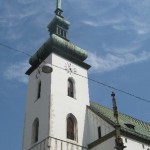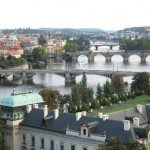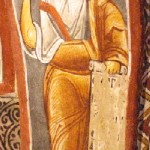
The first Toleranzpatent / Patent of toleration of 1781, whilst giving some religious freedom to protestants living within the Austro-Hungarian Empire, was still quite restrictive, in particular insisting that any buildings should not look like churches and should not have an entrance directly onto the street. It was only after Emperor Franz Joseph 1 issued his Protestantenpatent / Protestant patent in 1861, that non-Roman Catholics were finally allowed to build and own places of worship which actually looked like churches, with towers or spires and bells, etc.
Therefore within the borders of what is now the Czech Republic, there are numerous church buildings similar to this one in Litomerice, that date from the second half of the nineteenth century, and the early years of the twentieth century. Their architectural style is what I would describe as red-brick Victorian Gothic. In Czech they are known as Cervené kostely / Red or Dark Churches.
These Cervené kostely are located in towns and cities where there was a majority or a large German-speaking population and they were built for worship by German-speaking Lutherans. German-speakers were often the owners of factories and businesses and were wealthy enough to raise the necessary funds for their design and construction.
As I have previously written, Tomáš Garrigue Masaryk, the founder and first president of Czechoslovakia, was very keen that the boundaries of this new nation should be the historic ones of Bohemia and Moravia which predominantly follow the ridges of the surrounding hills and mountains. This was to ensure that the new nation had defensible borders and that also, nearly all Czech speakers would be living within those borders.
However, one important consequence of the adoption of these borders was that many people of German ethnic origin were also incorporated into Czechoslovakia. According to a census taken in 1921, just over three million Germans lived in Czechoslovakia accounting for around 23% of the country’s total population. The areas where Germans formed a majority were known as Sudetenland and the people themselves as the Sudetendeutsche.
In December 1918, less than two months after the new independent state of Czechoslovakia had come into existence, the Czech Lutheran Church and the Czech Presbyterian/Reformed Church agreed to unite, forming the Ceskobratrská církev evangelická (CCE) / Evangelical Church of Czech Brethren (ECCB). They were then, and still are, the largest Czech Protestant Church and celebrated the one hundredth anniversary of their formation in December last year.
But it was only the Czech-speaking Lutherans who joined the newly formed CCE/ECCB. A separate German-speaking Lutheran Church remained, until 1945.
In 1945, under the Potsdam agreement and the Beneš decrees, nearly all ethnic Germans were expelled from Czechoslovakia and the German-speaking Lutheran Church within the country, ceased to exist, leaving behind empty Cervené kostely.

It has been interesting visiting, photographing, and trying to discover what has happened to these abandoned Church buildings since 1945. The Cervený kostel in Brno, which I previously featured in this blog post about the city in 2012, is now in the hands of the CCE/ECCB and is used regularly by them for worship.
The Cervený kostel in Olomouc, which I haven’t visited, meaning that I don’t have a photograph, also initially passed to the CCE/ECCB. But in 1957, it was given to Palacký University and for many years, housed the archives of their Research Library. It is now to be revamped to become a new venue for concerts, exhibitions and a café.

The Cervený kostel in Litomerice, which I featured at the beginning of this post and can be seen again, from a different angle, in the photograph above, now belongs the relatively small Czech Baptist Union. But whether the Baptists in Litomerice had their own building prior to 1945, or how they were able to take over the former German Lutheran Church, is a mystery to which I don’t know the answer. There is no relevant information on their website.

The photograph above is of the Cervený kostel in Varnsdorf, a town which lies right on the border of the Czech Republic with Germany. So far as I can tell, the church is not currently used for anything. I believe it now belongs to the town council who appear to be about to carry out much needed repair work, judging by the recently erected scaffolding around the spire.

Kostel svatého Pavla, located in the centre of Ústí nad Labem, is another fine example of a Cervený kostel. Despite appearances, the building is not made of bricks, but of concrete, covered with glued red tiles to imitate bricks. The Czech Wikipedia article about this church explains that after 1945, all German inscriptions were either ground down or whitened so as to be no longer visible.
This Church is now co-owned and administered by the CCE/ECCB and the Czechoslovak Hussite Church (CCSH) who both use it for worship – the CCE/ECCB on Sunday mornings and the CCSH on Sunday afternoons.
I am well aware that there are several more Cervené kostely elsewhere in the Czech Republic which I hope to find, visit, and photograph, over the next few years. In the meantime, if anyone can throw more light on how, post 1945, they have ended up in the hands of their current owners, please do leave a comment here on my blog.
Finally, I once again apologise for the absence of some Czech diacritics. Unfortunately, as I have previously explained, my blog set-up can only cope with certain diacritics. Any it doesn’t like are rendered as question marks, and names such as Litom??ice and ?ervené kostely would appear in the text.




During one of Don Sparling’s brilliant guided walks around Brno, he explained that the red bricks were used by the city’s German builders as something typical that connected them – in most cases Protestants from the North of Germany – with the typical architectural style of their region of origin, i.e. the ‘North-German Gothic’. As a clear stance of differentiation, any public building erected by the Czech-speaking minority in the city were then fitted with a smooth cream / yellow / beige façade…
Thank you, Katka, for this very informative comment. And my thanks too, to Don Sparling. The Wikipedia article about Kostel svatého Pavla in Ústí nad Labem, to which I link in the post, explains that the building of that Church was funded by German businessmen who had moved to Ústí from Protestant regions of Germany. The architect was from Leipzig, a strongly Protestant city. But the fact that Czech-speakers of the time were determined that their public buildings should look distinctly different, is most fascinating.
Hi Ricky,
Those ‘Red Churches’ are impressive buildings, they exude a sense of strength, permanence and ‘belonging’ in their surroundings. It is surreal that in less than a century after they were built by the ‘Nord-Deutsche’ Lutheran community to express their faith and their place in society; that entire faith and linguistic community and culture were swept away and pushed out of the country entirely.
Of course there was a three way split in religious and cultural matters after 1918 in Czechoslovakia; with Protestant German, Roman Catholic German/Austrian and various Czech elements in play.
I often draw a parallel between Czech/Bohemian experience and Irish experience as opposite sides of the same coin. Both countries had a quasi-state religion imposed on them by an external political ruling class in an attempt to bring them into conformity with their rulers. In the Czech case this was the re-imposition of Roman Catholicism by the Holy Roman Empire (later Austro-Hungarian Empire) after the end of the Hussite and Thirty Years Wars. In Ireland it was the imposition of Protestantism by the Tudor and Orange Monarchies and the Parliamentarians of the English Civil Wars. I am often surprised by peoples reactions when I make this comparison.
Finally, isn’t it sad that language, culture or nationalism should divide one church? A German Lutheran church and the CCE/ECCB side by side but separate.
Thanks for this post Ricky, there are often hidden depths and twists in the seemingly obvious stories of our built environment. Who would think that cream/yellow or beige would assume cultural and political significance?
Take care,
Sean
Hi Sean,
These red churches are very impressive, as you say. Also, they are nearly all very large, with the exception of the one in Litomerice which is a little smaller.
The comparison you make in your second paragraph is a very astute observation and one with which I would highly agree. In both cases, seeking to bring the people into conformity with their rulers was exactly what both the Habsburgs in Czech lands & the English ruling class in Ireland, tried to do, using religion as their tool.
Likewise, I share your sadness that in 1918, the revival of the Czech language and the resultant nationalism, led to the division of the Lutheran Church in the new state of Czechoslovakia. Whilst these days, there are very strong links between the CCE/ECCB and the EKD in Germany, apparently there were some tensions in the initial years following the Velvet Revolution, over the whole issue of the expulsion of German-speaking Lutherans and associated property rights.
Ricky: Whenever I check into your latest post I always find something interesting. This post on the “red” churches stirs the latent historian in this aged chemist. It is amazing what sort of history one can find in a country with a history as old as Czech Republic. Congratulations to you also Sean for your insights on Irish history. My wife, Elaine is of German and Irish parentage with the Irish (gentle and kind personality) half predominating. Ricky how much autumn color is in the landscape at present?
Bob
Bob – I’m very pleased to know that I’ve stirred the latent historian in you! Whilst I had a fairly good grasp of European history before moving to the Czech Republic eleven years ago, it has been considerably expanded since living here as I’ve sought to understand the area where I now live & the places I’ve been able to visit. And I second your congratulations to Sean!
To answer the question in your final sentence – the trees have noticeably started changing colour over the past ten days or so. There is also increasing leaf fall, aided by some very strong winds we’ve experience over the last 36 hours.